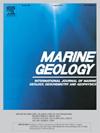西南印度洋脊两侧40 kyr沉积物记录中的热液羽流事件
IF 2.2
3区 地球科学
Q2 GEOSCIENCES, MULTIDISCIPLINARY
引用次数: 0
摘要
热液柱在海洋的化学通量和元素运输中起着关键作用。然而,对洋中脊两侧沉积物的影响并没有得到很好的限制。本文分析了西南印度洋脊(SWIR)侧翼3个沉积物岩心(MC03/04/05)过去40ka的地球化学记录。除了主要的CaO含量外,这些侧翼沉积物中Fe、Mn、Cu、Zn和ree浓度升高,Y呈阳性异常。我们还构建了Cu/Zn-Mn/Fe-REE/Fe和REE/Fe vs. Mn/Fe地球化学图来识别热液柱输入。基于这些结果,我们揭示了32-30 ka (MC04)、16-14 ka (MC05)、10-8 ka (MC05)和7.5-6.5 ka (MC03)的4次远端羽流事件。聚类分析表明,这些羽流事件起源于玉黄热液田,与该热液田内硫化物形成的时间相对应。最后,我们认为YHF羽流弥散与阿古拉斯回流(Agulhas Return Current, ARC)迁移耦合,导致以下过程:(1)32-30 ka南向ARC将羽流物质输送到MC04;(2) 16-14 ka和10-8 ka向北移动的MC05沉积羽流沉降物;(3) 7.5 ~ 6.5 ka南向弧运动导致MC03沉积。我们的发现揭示了金属(Fe, Mn, REE)从SWIR轴向区到远侧翼的运输机制,突出了千年时间尺度上羽-弧的相互作用。本文章由计算机程序翻译,如有差异,请以英文原文为准。
Hydrothermal plume events in a 40 kyr sediment record from the flanks of the Southwest Indian Ridge
Hydrothermal plumes play a critical role in chemical fluxes and element transport in the oceans. However, the impact on the sediments along mid-ocean ridge flanks is not well constrained. In this study, samples from three sediment cores (MC03/04/05) were analyzed for their geochemical records located at the Southwest Indian Ridge (SWIR) flanks over the past 40 ka. In addition to the dominant CaO content, these flank sediments show elevated concentrations of Fe, Mn, Cu, Zn, and REEs with positive Y anomalies. We also constructed two geochemical diagrams (Cu/Zn-Mn/Fe-REE/Fe and REE/Fe vs. Mn/Fe) to identify hydrothermal plume inputs. Based on these results, we revealed four distal plume events at 32–30 ka (MC04), 16–14 ka (MC05), 10–8 ka (MC05), and 7.5–6.5 ka (MC03). Furthermore, cluster analysis indicates that these plume events originated from the Yuhuang Hydrothermal Field (YHF), and they correspond temporally to periods of sulfide formation within the field. Finally, we propose that the YHF plume dispersion was coupled with the Agulhas Return Current (ARC) migration, resulting in the following processes: (1) 32–30 ka southward ARC transported plume material to MC04; (2) 16–14 ka and 10–8 ka northward shifts deposited plume fallout at MC05; (3) 7.5–6.5 ka southward ARC movement led to MC03 deposition. Our findings reveal metal (Fe, Mn, REE) transport mechanisms from the SWIR axial zones to distal flanks, highlighting plume-ARC interactions over millennial timescales.
求助全文
通过发布文献求助,成功后即可免费获取论文全文。
去求助
来源期刊

Marine Geology
地学-地球科学综合
CiteScore
6.10
自引率
6.90%
发文量
175
审稿时长
21.9 weeks
期刊介绍:
Marine Geology is the premier international journal on marine geological processes in the broadest sense. We seek papers that are comprehensive, interdisciplinary and synthetic that will be lasting contributions to the field. Although most papers are based on regional studies, they must demonstrate new findings of international significance. We accept papers on subjects as diverse as seafloor hydrothermal systems, beach dynamics, early diagenesis, microbiological studies in sediments, palaeoclimate studies and geophysical studies of the seabed. We encourage papers that address emerging new fields, for example the influence of anthropogenic processes on coastal/marine geology and coastal/marine geoarchaeology. We insist that the papers are concerned with the marine realm and that they deal with geology: with rocks, sediments, and physical and chemical processes affecting them. Papers should address scientific hypotheses: highly descriptive data compilations or papers that deal only with marine management and risk assessment should be submitted to other journals. Papers on laboratory or modelling studies must demonstrate direct relevance to marine processes or deposits. The primary criteria for acceptance of papers is that the science is of high quality, novel, significant, and of broad international interest.
 求助内容:
求助内容: 应助结果提醒方式:
应助结果提醒方式:


